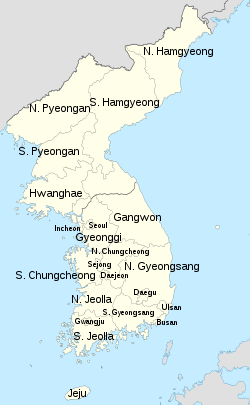Type a search term to find related articles by LIMS subject matter experts gathered from the most trusted and dynamic collaboration tools in the laboratory informatics industry.
| Province 도 (道) | |
|---|---|
 | |
| Category | Unitary state |
| Location | |
| Number | 22 15 controlled by ROK 5 controlled by DPRK 2 split between ROK and DPRK |
| Populations | 276,589 (Sejong) – 13,413,459 (Gyeonggi Province) |
| Areas | 1,849 km2 (714 sq mi) (Jeju) – 19,030 km2 (7,350 sq mi) (North Gyeongsang Province) – 20,569 km2 (7,942 sq mi) (Gangwon including the North Korean province) |
| Government |
|
| Province | |
| Hangul | 도 |
|---|---|
| Hanja | |
| Revised Romanization | do |
| McCune–Reischauer | to |
| Special self-governing province | |
| Hangul | 특별자치도 |
| Hanja | |
| Revised Romanization | teukbyeoljachido |
| McCune–Reischauer | tŭkpyŏljach'ido |
Provinces are one of the first-level divisions within South Korea. There are 9 provinces in South Korea: North Chungcheong, South Chungcheong, Gangwon State, Gyeonggi, North Gyeongsang, South Gyeongsang, North Jeolla Province, South Jeolla, and Jeju Special Self-Governing Province.
Although the details of local administration have changed dramatically over time, the basic outline of the current three-tiered system was implemented under the reign of Gojong in 1895. A similar system also remains in use in North Korea.
Provinces (도, 道) are the highest-ranked administrative divisions in South Korea, which follows the East Asian tradition name Circuit (administrative division). Along with the common provinces, there are four types of special administrative divisions with equal status: special self-governing province, special city, metropolitan city, and special self-governing city.
Special Self-governing Province or State (특별자치도, 特別自治道) is a type of provinces with more autonomy over its economy and more powers are given to the provincial government. Jeju, Gangwon, and Jeonbuk are the only special self-governing provinces in South Korea, while Seoul is the only special city and Sejong is the only special self-governing city.
Governors for the provinces and mayors for the special/metropolitan cities are elected every four years. Current governors and mayors are listed at List of governors of South Korea.
| Name | Official English name | Hangul | Hanja | ISO | Pop. (2020)[1] |
Area (km2) |
Density 2020 (/km2) |
Capital | Historical province |
Cultural region |
Abbreviation | ||
|---|---|---|---|---|---|---|---|---|---|---|---|---|---|
| Chungcheongbuk-do[2] | 충청북도 | 忠淸北道 | KR-43 | 1,632,088 | 7,433[3] | 219.6 | Cheongju | Chungcheong | Hoseo | Chungbuk | 충북 | 忠北 | |
| Chungcheongnam-do[2] | 충청남도 | 忠淸南道 | KR-44 | 2,176,636 | 8,204[4] | 265.3 | Hongseong | Chungnam | 충남 | 忠南 | |||
| Gangwon State[citation needed] | 강원특별자치도 | 江原特別自治道 | KR-42 | 1,521,763 | 20,569[5] | 74.0 | Chuncheon | Gangwon | Gwandong | Gangwon | 강원 | 江原 | |
| Gyeonggi-do[2] | 경기도 | 京畿道 | KR-41 | 13,511,676 | 10,171[6] | 1,328.5 | Suwon | Gyeonggi | Sudogwon | Gyeonggi | 경기 | 京畿 | |
| Gyeongsangbuk-do[2] | 경상북도 | 慶尙北道 | KR-47 | 2,644,757 | 19,030[7] | 139.0 | Andong | Gyeongsang | Yeongnam | Gyeongbuk | 경북 | 慶北 | |
| Gyeongsangnam-do[2] | 경상남도 | 慶尙南道 | KR-48 | 3,333,056 | 10,532[8] | 316.5 | Changwon | Gyeongnam | 경남 | 慶南 | |||
| Jeonbuk State[9] | 전북특별자치도 | 全北特別自治道 | KR-45 | 1,802,766 | 8,043 | 224.1 | Jeonju | Jeolla | Honam | Jeonbuk | 전북 | 全北 | |
| Jeollanam-do[2] | 전라남도 | 全羅南道 | KR-46 | 1,788,807 | 11,858 | 150.9 | Muan | Jeonnam | 전남 | 全南 | |||
| Jeju Special Self-Governing Province[2] |
제주특별자치도 | 濟州特別自治道 | KR-49 | 670,858 | 1,849[10] | 362.8 | Jeju | Jeju | Jeju | 제주 | 濟州 | ||
| This article is part of a series on the |
| Administrative divisions of South Korea |
|---|
| Provincial level |
| Province (list) |
| Special self-governing province (Jeju, Gangwon and North Jeolla) |
| Special city (Seoul) |
| Metropolitan city (list) |
| Special self-governing city (Sejong) |
| Municipal level |
| Specific city (list) |
| City (list) |
| County (list) |
| Autonomous District (list) |
| Submunicipal level |
| Administrative city (list) |
| Non-autonomous District (list) |
| Neighborhoods and Towns |
| Town (list) |
| Township (list) |
| Neighborhood (list) |
| Villages |
| Village (list) |
| Communities |
| Ward |
South Korea claims five provinces on the territory controlled by North Korea. These claimed provinces are managed by the Committee for the Five Northern Korean Provinces (Korean: 이북5도위원회; Hanja: 以北五道委員會). These provinces are based on the divisions of the Korean Empire era and are different from the present North Korean provinces.
| Historical province | Name | Hangul | Hanja | Area (km2) | Capital | Cultural region | Abbreviation | ||
|---|---|---|---|---|---|---|---|---|---|
| Hamgyeong | North Hamgyeong | 함경북도 | 咸鏡北道 | 20,345 | Cheongjin | Gwanbuk | Hambuk | 함북 | 咸北 |
| South Hamgyeong | 함경남도 | 咸鏡南道 | 31,977 | Hamheung | Gwannam | Hamnam | 함남 | 咸南 | |
| Pyeongan | North Pyeongan | 평안북도 | 平安北道 | 28,443 | Sinuiju | Gwanseo | Pyeongbuk | 평북 | 平北 |
| South Pyeongan | 평안남도 | 平安南道 | 14,944 | Pyongyang | Pyeongnam | 평남 | 平南 | ||
| Hwanghae | Hwanghae | 황해도 | 黃海道 | 16,744 | Haeju | Haeseo | Hwanghae | 황해 | 黃海 |